| New York State Comptroller | |
|---|---|
.svg.png.webp) Seal of the State of New York | |
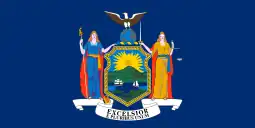 Flag of the State of New York | |
| Department of Audit and Control[1] | |
| Style |
|
| Term length | Four years |
| Constituting instrument | New York Constitution, Executive Law |
| Formation | 1797 |
| First holder | Samuel Jones |
| Salary | $210,000 (2019) |
| Website | Official website |
The New York State Comptroller is an elected constitutional officer of the U.S. state of New York and head of the New York state government's Department of Audit and Control.[2] Sixty-one individuals have held the office of State Comptroller since statehood. The incumbent is Thomas DiNapoli, a Democrat.
Powers and duties
The State Comptroller is in effect New York's chief fiscal officer. Article V, Section 1, of the New York Constitution requires the State Comptroller "to audit all vouchers before payment and all official accounts", "to audit the accrual and collection of all revenues and receipts", and "to prescribe such methods of accounting as are necessary for the performance of the foregoing duties". Furthermore, the State Constitution vests the safekeeping and protection of all state funds in the State Comptroller, stating: "[t]he payment of any money of the state, or of any money under its control, or the refund of any money paid to the state, except upon audit by the comptroller, shall be void..."[3] In accordance with this constitutional framework, the State Comptroller has broad superintending authority unlike any other state auditor or treasurer in the nation to ensure that state agencies and local governments alike use taxpayer money effectively and efficiently to promote the common good. For example, the State Comptroller:
- Serves as sole trustee of the $258.1 billion New York State Common Retirement Fund (value as of March 31, 2021), making the State Comptroller and his or her Department of Audit and Control one of the largest institutional investors in the world;
- Administers the New York State and Local Retirement System for public employees, with more than one million members, retirees and beneficiaries and more than 3,000 employers;
- Prescribes and maintains the state's accounting system and administers the State's approximately $16.7 billion payroll;
- Reports on the condition of the state's finances;
- Manages and issues the state debt;
- Reviews state contracts and audits payments to vendors;
- Conducts financial, compliance, and performance audits of local governments, state agencies, and public benefit corporations;
- Oversees the fiscal affairs of local governments, including New York City, and prescribes uniform systems of accounts, budgets, and financial reports therefor;
- Investigates waste, fraud, and abuse of public resources;
- Stewards the Justice Court Fund and the Oil Spill Fund;
- Functions as custodian of more than $17 billion in unclaimed funds, restoring lost accounts to their rightful owners; and
- Holds training conferences and provides technical assistance to improve state and local government operations.[4]
History
In 1776, the New York Provincial Congress appointed an Auditor-General to settle the public accounts. After his resignation, the Council of Appointment appointed an Auditor to succeed. In 1797, the office of the State Comptroller was created by the State Legislature to succeed the State Auditor. The Comptroller was appointed by the Council of Appointment to a one-year term, and could be re-appointed without term limit. In 1800, the Legislature reduced the salary of the Comptroller from $3,000 to $2,500, and Samuel Jones declined to be re-appointed.
Under the Constitution of 1821, the Comptroller was elected by joint ballot of the New York State Legislature to a three-year term. Under the Constitution of 1846, the office became elective by general election, and the Comptroller was elected with the other state cabinet officers in odd years to a two-year term, serving in the second year of the governor in office and the first year of the succeeding governor. The comptroller was elected in 1895 to a three-year term, and subsequently the state officers were elected in even years and served a two-year term concurrently with the governor. In 1926, the responsibilities of the New York State Treasurer were transferred to the Comptroller as the head of the Department of Audit and Control. Since 1938, the comptroller has been elected to a four-year term, like the governor.
New York State Comptrollers
| Image | Name | Took office | Left office | Party | Notes |
|---|---|---|---|---|---|
.png.webp) |
Comfort Sands | July 24, 1776 | March 23, 1782 | as Auditor-General [5] | |
| Peter T. Curtenius | April 2, 1782 | 1797 | as Auditor | ||
.png.webp) |
Samuel Jones | March 15, 1797 | March 12, 1800 | ||
.png.webp) |
John Vernon Henry | March 12, 1800 | August 10, 1801 | Federalist | |
.png.webp) |
Elisha Jenkins | August 10, 1801 | March 16, 1806 | Dem.-Rep. | appointed Secretary of State |
.png.webp) |
Archibald McIntyre | March 26, 1806 | February 12, 1821 | Dem.-Rep./Clintonian | |
.png.webp) |
John Savage | February 12, 1821 | January 29, 1823 | Dem.-Rep. | appointed Chief Justice of the New York Supreme Court |
 |
William L. Marcy | February 13, 1823 | January 21, 1829 | Dem.-Rep./Bucktail | appointed to the New York Supreme Court shortly before the end of his second term |
 |
Silas Wright | January 27, 1829 | January 7, 1833 | Democratic | elected a U.S. Senator from New York during his second term |
 |
Azariah C. Flagg | January 11, 1833 | February 4, 1839 | Democratic | two terms |
.png.webp) |
Bates Cooke | February 4, 1839 | January 1841 | Whig | resigned because of bad health |
 |
John A. Collier | January 27, 1841 | February 7, 1842 | Whig | elected to a term of three years, but in 1842 all Whig state officers were removed by Democratic majority of the State Legislature |
 |
Azariah C. Flagg | February 7, 1842 | December 31, 1847 | Democratic | two terms, legislated out of office by the Constitution of 1846 |
 |
Millard Fillmore | January 1, 1848 | February 20, 1849 | Whig | first Comptroller elected by general ballot; went on to be U.S. Vice President and President |
 |
Washington Hunt | February 20, 1849 | December 18, 1850 | Whig | elected by the State Legislature to fill unexpired term, then re-elected, then elected Governor of New York |
 |
Philo C. Fuller | December 18, 1850 | December 31, 1851 | Whig | appointed to fill unexpired term |
.png.webp) |
John C. Wright | January 1, 1852 | December 31, 1853 | Democratic | |
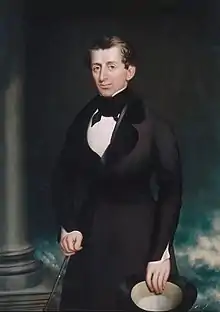 |
James M. Cook | January 1, 1854 | December 31, 1855 | Whig | |
 |
Lorenzo Burrows | January 1, 1856 | December 31, 1857 | American | |
 |
Sanford E. Church | January 1, 1858 | December 31, 1859 | Democratic | |
 |
Robert Denniston | January 1, 1860 | December 31, 1861 | Republican | |
 |
Lucius Robinson | January 1, 1862 | December 31, 1865 | Union | two terms |
_from_Prominent_and_Progressive_Americans%252C_1902.png.webp) |
Thomas Hillhouse | January 1, 1866 | December 31, 1867 | Republican | |
 |
William F. Allen | January 1, 1868 | July 1, 1870 | Democratic | elected a judge of the New York Court of Appeals |
| Asher P. Nichols | July 1, 1870 | December 31, 1871 | Democratic | appointed to fill unexpired term, elected for the remainder of the term in Nov. 1870 | |
.jpg.webp) |
Nelson K. Hopkins | January 1, 1872 | December 31, 1875 | Republican | two terms |
 |
Lucius Robinson | January 1, 1876 | December 31, 1876 | Democratic | elected Governor of New York |
 |
Frederic P. Olcott | January 1, 1877 | December 31, 1879 | Democratic | appointed to fill unexpired term, then elected for a full term in Nov. 1877 |
 |
James W. Wadsworth | January 1, 1880 | December 31, 1881 | Republican | |
 |
Ira Davenport | January 1, 1882 | December 31, 1883 | Republican | |
 |
Alfred C. Chapin | January 1, 1884 | December 31, 1887 | Democratic | two terms |
 |
Edward Wemple | January 1, 1888 | December 31, 1891 | Democratic | two terms |
.png.webp) |
Frank Campbell | January 1, 1892 | December 31, 1893 | Democratic | |
 |
James A. Roberts | January 1, 1894 | December 31, 1898 | Republican | two terms (1894–95, 1896–98) |
 |
William J. Morgan | January 1, 1899 | September 5, 1900 | Republican | died in office |
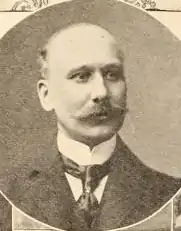 |
Theodore P. Gilman | September 5, 1900 | December 31, 1900 | Republican | as First Deputy Comptroller acted until being appointed to fill unexpired term |
 |
Erastus C. Knight | January 1, 1901 | December 28, 1901 | Republican | elected Mayor of Buffalo |
 |
Nathan L. Miller | December 30, 1901 | November 1903 | Republican | appointed to fill unexpired term, then elected for a full term in Nov. 1902, then resigned to take office as a justice of the New York Supreme Court |
 |
Otto Kelsey | November 12, 1903 | May 2, 1906 | Republican | appointed to fill unexpired term, then elected for a full term in Nov. 1904, then appointed Superintendent of Insurance |
| William C. Wilson | May 2, 1906 | December 31, 1906 | Republican | as First Deputy Comptroller acted until being appointed on November 8 to fill unexpired term | |
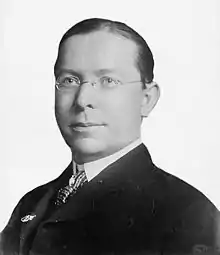 |
Martin H. Glynn | January 1, 1907 | December 31, 1908 | Democratic | |
 |
Charles H. Gaus | January 1, 1909 | October 31, 1909 | Republican | died in office |
 |
Otto Kelsey | October 31, 1909 | November 11, 1909 | Republican | as First Deputy Comptroller acted until the appointment of a successor |
.png.webp) |
Clark Williams | November 11, 1909 | December 31, 1910 | Republican | appointed to fill unexpired term |
 |
William Sohmer | January 1, 1911 | December 31, 1914 | Democratic | two terms |
 |
Eugene M. Travis | January 1, 1915 | December 31, 1920 | Republican | three terms |
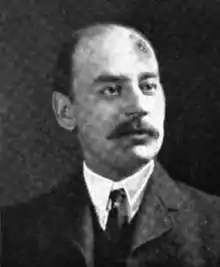 |
James A. Wendell | January 1, 1921 | May 10, 1922 | Republican | died in office |
 |
William J. Maier | May 10, 1922 | December 31, 1922 | Republican | as First Deputy Comptroller acted until being appointed on May 22 to fill unexpired term |
.jpg.webp) |
James W. Fleming | January 1, 1923 | December 31, 1924 | Democratic | |
.jpg.webp) |
Vincent B. Murphy | January 1, 1925 | December 31, 1926 | Republican | |
.jpg.webp) |
Morris S. Tremaine | January 1, 1927 | October 12, 1941 | Democratic | seven terms, died in office |
| Harry D. Yates | October 12, 1941 | October 17, 1941 | Democratic | as First Deputy Comptroller acted until the appointment of a successor | |
| Joseph V. O'Leary | October 17, 1941 | December 31, 1942 | American Labor | appointed to fill unexpired term | |
.png.webp) |
Frank C. Moore | January 1, 1943 | December 31, 1950 | Republican | two terms |
| J. Raymond McGovern | January 1, 1951 | December 31, 1954 | Republican | ||
.jpg.webp) |
Arthur Levitt Sr. | January 1, 1955 | December 31, 1978 | Democratic | six terms, longest-serving Comptroller (24 years) |
| Edward Regan | January 1, 1979 | May 7, 1993 | Republican | resigned in the middle of his fourth term | |
| Carl McCall | May 7, 1993 | December 31, 2002 | Democratic | elected by State Legislature to fill unexpired term, then re-elected twice | |
| Alan Hevesi | January 1, 2003 | December 22, 2006 | Democratic | re-elected to a second term, but resigned prior to its commencement[6] | |
| Thomas Sanzillo | December 22, 2006 | February 7, 2007 | as First Deputy Comptroller acted until the election of a successor by the State Legislature | ||
 |
Thomas DiNapoli | February 7, 2007 | present | Democratic | elected by the State Legislature to fill unexpired term, then re-elected four times |
Notes
- ↑ Division of the Budget Agency Appropriations
- ↑ Executive Law § 40. "There shall continue to be in the state government a department of audit and control. [...] The head of the department of audit and control shall be the comptroller. [...]"
- ↑ "Article V, Section 1, New York Constitution" (PDF). New York Senate. Retrieved December 9, 2021.
- ↑ "About the Comptroller's Office". Office of the New York State Comptroller. Retrieved December 9, 2021.
- ↑ Google Books: The New York Civil List compiled by Franklin Benjamin Hough (page 34; Weed, Parsons and Co., 1858)
- ↑ "Hevesi Resigns, Pleading Guilty to Fraud Count". The New York Times. 22 December 2006. Retrieved 12 March 2018.
.jpg.webp)
